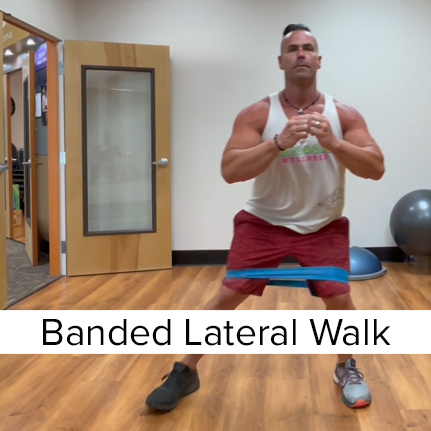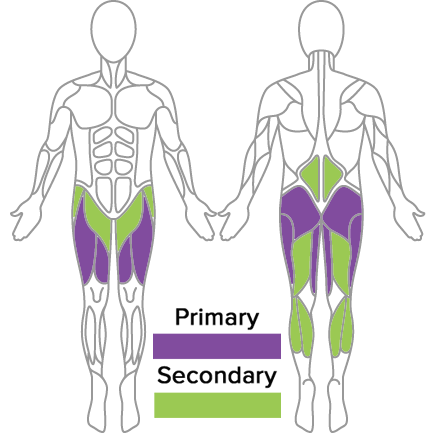Banded Lateral Walk
The lateral band walking exercise looks (and feels) pretty strange, but it's actually the perfect way to improve hip stability, strengthen the hip abductors and increase stability of the knee joint. As a part of a warmup routine, the lateral band walking exercise engages many of the deep muscles that stabilize the pelvis. Doing this exercise before working out can improve hip, foot, and ankle stability as well as knee joint stabilization. This, in turn, improves overall body mechanics and movement efficiency during.

Primary Muscles Used

Banded Lateral Walk Instructions
- In order for this exercise to be effective, you need to choose a resistance band with the right strength. Band colors used to indicate the level of resistance and progress. But now there are so many different companies, you just have to use trial and error. You want to choose a band that feels firm and challenging, but not impossible.
- Keeping the band flat, not bunched, place the band just above each ankle and wrapped around both legs.
- Position your feet shoulder-width apart.
- The band should be taut, but not stretched. Bend your knees slightly and move into a half-squat position to activate the gluteus medius.
- Keep your feet in line with your shoulders and face forward with your body weight evenly distributed over both feet.
- Maintaining the half-squat position, shift your weight over one leg and take a step sideways with the other leg.
- Keep stepping the same way until the end, then step back the other direction.
- Keep your hips level during the movement.
- With this exercise, it helps to maintain a low, forward-facing posture. Your back should be straight, not rounded.

Tim's list of benefits for the Banded Lateral Walk
- The lateral band walking exercise is particularly helpful for any athlete who engages in sports that require running, jumping, pivoting and twisting. A weak gluteus medius—one of the muscles on the side of the hip—can lead to problems in the knee joint. In fact, it's often the underlying reason for knee pain and injury, especially ACL injuries. A strong gluteus medius not only stabilizes the hip but helps to maintain proper tracking in the knee joint by reducing lateral stress on the knee.
- Performing the lateral band walking exercise protects the knee by training correct movement patterns at the knee joint so it doesn't cave in or out. Maintaining proper tracking is important when landing a jump safely. Many experts believe improper knee movement biomechanics is one factor that explains why female athletes have a disproportional incidence of ACL injuries.
- Do your knees bow in? Most likely it is weak abductors causing the problem. The banded lateral walk will correct this problem.
Are you ready to take your workouts to the next level? Are you interested in getting great recipe ideas? Do you want customized mindfulness excises and nutrition? We will set you up with your own custom program whether you workout in a gym, at your home, or anywhere in-between. Get real results, from a real expert! Click here to sign up!
Click here to go back to the full exercise list.
